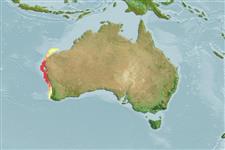Classification / Names
आम नाम | उपशब्द | Catalog of Fishes(वर्ग, प्रजाति) | ITIS | CoL | WoRMS | Cloffa
>
Aulopiformes (Grinners) >
Pseudotrichonotidae (Sand diving lizardfishes)
Etymology: Pseudotrichonotus: Greek, pseudes = false + Greek, thrix, -ichos = hair + Greek,noton = back (Ref. 45335); belos: Name from Greek meaning arrow or dart, referring to the dart-like appearance of the species; noun in apposition..
Environment: milieu / climate zone / depth range / distribution range
पारिस्थितिकी
समुद्री ड़िमरसल; गहराई सीमा 100 - 120 m (Ref. 117888). Tropical
वितरण
देश | ऐफ ऐ ओ क्षेत्र | Ecosystems | संयोग | Point map | भूमिका | Faunafri
Eastern Indian Ocean, Western Australia.
आकार / वज़न / Age
Maturity: Lm ? range ? - ? cm
Max length : 4.1 cm SL पुल्लिंग / अलिंग; (Ref. 117888)
Short description
आकृति विज्ञान | मौरफोमैटरिक्स
पृष्ठीय सौफट रेज़ (सम्पूर्ण): 31-33; ऐनल सौफट रेज़: 12; जानवरों की रीड़ का जोड़: 48 - 50. This species is distinguished from its congeners by the following characters: Dorsal-fin origin is well behind the pelvic fin origin, predorsal length 39.6-41.2% SL; D 31-33; A 12 (Ref. 117888).
This species was collected from 100 m on sand, possibly from finer shell hash deposits. This collection also yielded high diversity of other organisms, including a large amount of sponges, as well as rubble while the second area of collection included gorgonians and shell hash (Ref.117888)
Life cycle and mating behavior
परिपक्व अवधि | पुनरुत्पत्ति | मछलीऔ का अंडे देना | अंडे | Fecundity | लार्वा
Gill, A.C. and J.J. Pogonoski, 2016. Pseudotrichonotus belos new species, first record of the fish family Pseudotrichonotidae from the Australia (Teleostei: Aulopiformes). Zootaxa 4205(2):189-193. (Ref. 117888)
IUCN Red List Status (Ref. 130435)
Threat to humans
Harmless
Human uses
अधिक जानकारी
देशऐफ ऐ ओ क्षेत्रEcosystemsसंयोगभूमिकाStocksपारिस्थितिकीआहारखाद्य पदार्थआहार खपतखोराक
आम नामउपशब्दचपायचयपरभक्षीईकोटोकसीकोलौजीपुनरुत्पत्तिपरिपक्व अवधिमछलीऔ का अंडे देनाSpawning aggregationFecundityअंडेEgg development
Age/Sizeबाढ़Length-weightLength-lengthLength-frequenciesमौरफोमैटरिक्सआकृति विज्ञानलार्वालारवल गतिकीभर्तीबहुतायतBRUVS
संदर्भजलीयकृषिजलीयकृषि रूपरेखाखींचआनुवंशिकीElectrophoresesहैरेटिबिलटीबीमारीप्रक्रमणNutrientsMass conversion
सहयोगीयोतस्वीरेStamps, Coins Misc.ध्वनिसिगुयटिरारफ्तारतैरने के प्रकारगिल क्षेत्रOtolithsदिमागदृष्टि
साधन
Special reports
Download XML
इंटरनेट स्रोत
Estimates based on models
Phylogenetic diversity index (Ref.
82804): PD
50 = 0.6250 [Uniqueness, from 0.5 = low to 2.0 = high].
Bayesian length-weight: a=0.00389 (0.00180 - 0.00842), b=3.12 (2.94 - 3.30), in cm total length, based on all LWR estimates for this body shape (Ref.
93245).
Trophic level (Ref.
69278): 3.4 ±0.6 se; based on size and trophs of closest relatives
Fishing Vulnerability (Ref.
59153): Low vulnerability (10 of 100).
